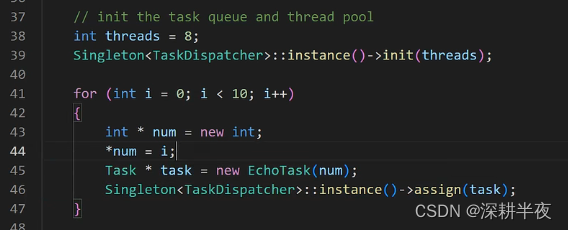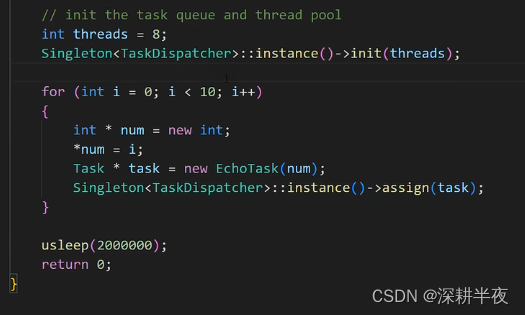1.线程池原理
面对多并发任务时频繁的创建线程会大大降低系统效率,会浪费时间,因此使用线程池 使线程在完成一个任务之后不销毁继续完成下一个任务;
线程池 :是多线程的拓展 对多线程进行管理;
线程池相当于生产者消费者模型 维护一个任务队列和若干个消费者线程;
2.线程池的组成

线程池分为三部分,每个部分相互配合就构成线程池:
2.1.任务队列,存储需要处理的任务,由工作的线程来处理这些任务
生产者通过线程池提供API接口将任务放入任务队列 ,消费者通过不停地循环从任务队列取任务
已处理的任务会被从任务队列中删除
线程池的使用者--生产者线程,也就是调用线程池函数往任务队列中添加任务的线程
任务队列里的任务都是函数的地址(回调函数) 基于地址对函数进行调用
回调函数:如果你把函数的指针(地址)作为参数传递给另一个函数,当这个指针被用来调用其所指向的函数时,就说这是回调函数。-----将函数地址作为参数传递,调用时成为回调函数
2.2.工作的线程(任务队列任务的消费者) ,N个
线程池中维护了一定的工作线程, 他们的作用是是不停的读任务队列, 从里边取出任务并处理
工作的线程相当于是任务队列的消费者角色,
若队列为空 则需要阻塞((使用条件变量/信号量阻塞);若队列满则堵塞生产者。
2.3.管理者线程(不处理任务队列中的任务),1个
它的任务是周期性(sleep实现)的对任务队列中的任务数量以及处于忙状态的工作线程个数进行检测。多了就创建一些工作线程,少了就销毁一些工作线程。
3.通过VS编写代码 在使用SSH传到linux中进行测试
3.线程池的创建
手撕线程池
3.1任务队列
// 任务结构体
typedef struct Task
{
void (*function)(void* arg);//不知道是什么类型 所以void* 可以接受各种类型
void* arg;
}Task3.2线程池定义
// 线程池结构体
struct ThreadPool
{
// 任务队列
Task* taskQ;
int queueCapacity; // 容量
int queueSize; // 当前任务个数
int queueFront; // 队头 -> 取数据
int queueRear; // 队尾 -> 放数据
pthread_t managerID; // 管理者线程ID
pthread_t *threadIDs; // 工作的线程ID
int minNum; // 最小线程数量
int maxNum; // 最大线程数量
int busyNum; // 忙的线程的个数
int liveNum; // 存活的线程的个数
int exitNum; // 要销毁的线程个数
pthread_mutex_t mutexPool; // 锁整个的线程池
pthread_mutex_t mutexBusy; // 锁busyNum变量
pthread_cond_t notFull; // 任务队列是不是满了
pthread_cond_t notEmpty; // 任务队列是不是空了
int shutdown; // 是不是要销毁线程池, 销毁为1, 不销毁为0
};3.3头文件声明
#ifndef _THREADPOOL_H
#define _THREADPOOL_H
typedef struct ThreadPool ThreadPool;//结构体在其他文件定义 需要再次声明
// 创建线程池并初始化
ThreadPool *threadPoolCreate(int min, int max, int queueSize);
//因为需要线程池实例所以函数返回类型 为ThreadPool
//因为需要对函数进行操作 所以需要函数指针 调用指针来调用函数
// 销毁线程池
int threadPoolDestroy(ThreadPool* pool);
// 给线程池添加任务
void threadPoolAdd(ThreadPool* pool, void(*func)(void*), void* arg);
// 获取线程池中工作的线程的个数
int threadPoolBusyNum(ThreadPool* pool);
// 获取线程池中活着的线程的个数
int threadPoolAliveNum(ThreadPool* pool);
//
// 工作的线程(消费者线程)任务函数
void* worker(void* arg);
// 管理者线程任务函数
void* manager(void* arg);
// 单个线程退出
void threadExit(ThreadPool* pool);
#endif // _THREADPOOL_H3.4源文件定义

ThreadPool* threadPoolCreate(int min, int max, int queueSize)
{
ThreadPool* pool = (ThreadPool*)malloc(sizeof(ThreadPool));
do
{
if (pool == NULL)
{
printf("malloc threadpool fail...\n");
break;
}
pool->threadIDs = (pthread_t*)malloc(sizeof(pthread_t) * max);
if (pool->threadIDs == NULL)
{
printf("malloc threadIDs fail...\n");
break;
}
memset(pool->threadIDs, 0, sizeof(pthread_t) * max);
pool->minNum = min;
pool->maxNum = max;
pool->busyNum = 0;
pool->liveNum = min; // 和最小个数相等
pool->exitNum = 0;
if (pthread_mutex_init(&pool->mutexPool, NULL) != 0 ||
pthread_mutex_init(&pool->mutexBusy, NULL) != 0 ||
pthread_cond_init(&pool->notEmpty, NULL) != 0 ||
pthread_cond_init(&pool->notFull, NULL) != 0)
{
printf("mutex or condition init fail...\n");
break;
}
// 任务队列
pool->taskQ = (Task*)malloc(sizeof(Task) * queueSize);
pool->queueCapacity = queueSize;
pool->queueSize = 0;
pool->queueFront = 0;
pool->queueRear = 0;
pool->shutdown = 0;
// 创建线程
pthread_create(&pool->managerID, NULL, manager, pool);
for (int i = 0; i < min; ++i)
{
pthread_create(&pool->threadIDs[i], NULL, worker, pool);
}
return pool;
} while (0);
// 释放资源
if (pool && pool->threadIDs) free(pool->threadIDs);
if (pool && pool->taskQ) free(pool->taskQ);
if (pool) free(pool);
return NULL;
}
int threadPoolDestroy(ThreadPool* pool)
{
if (pool == NULL)
{
return -1;
}
// 关闭线程池
pool->shutdown = 1;
// 阻塞回收管理者线程
pthread_join(pool->managerID, NULL);
// 唤醒阻塞的消费者线程
for (int i = 0; i < pool->liveNum; ++i)
{
pthread_cond_signal(&pool->notEmpty);
}
// 释放堆内存
if (pool->taskQ)
{
free(pool->taskQ);
}
if (pool->threadIDs)
{
free(pool->threadIDs);
}
pthread_mutex_destroy(&pool->mutexPool);
pthread_mutex_destroy(&pool->mutexBusy);
pthread_cond_destroy(&pool->notEmpty);
pthread_cond_destroy(&pool->notFull);
free(pool);
pool = NULL;
return 0;
}
void threadPoolAdd(ThreadPool* pool, void(*func)(void*), void* arg)
{
pthread_mutex_lock(&pool->mutexPool);
while (pool->queueSize == pool->queueCapacity && !pool->shutdown)
{
// 阻塞生产者线程
pthread_cond_wait(&pool->notFull, &pool->mutexPool);
}
if (pool->shutdown)
{
pthread_mutex_unlock(&pool->mutexPool);
return;
}
// 添加任务
pool->taskQ[pool->queueRear].function = func;
pool->taskQ[pool->queueRear].arg = arg;
pool->queueRear = (pool->queueRear + 1) % pool->queueCapacity;
pool->queueSize++;
pthread_cond_signal(&pool->notEmpty);
pthread_mutex_unlock(&pool->mutexPool);
}
int threadPoolBusyNum(ThreadPool* pool)
{
pthread_mutex_lock(&pool->mutexBusy);
int busyNum = pool->busyNum;
pthread_mutex_unlock(&pool->mutexBusy);
return busyNum;
}
int threadPoolAliveNum(ThreadPool* pool)
{
pthread_mutex_lock(&pool->mutexPool);
int aliveNum = pool->liveNum;
pthread_mutex_unlock(&pool->mutexPool);
return aliveNum;
}
void* worker(void* arg)
{
ThreadPool* pool = (ThreadPool*)arg;
while (1)
{
pthread_mutex_lock(&pool->mutexPool);
// 当前任务队列是否为空
while (pool->queueSize == 0 && !pool->shutdown)
{
// 阻塞工作线程
pthread_cond_wait(&pool->notEmpty, &pool->mutexPool);
// 判断是不是要销毁线程
if (pool->exitNum > 0)
{
pool->exitNum--;
if (pool->liveNum > pool->minNum)
{
pool->liveNum--;
pthread_mutex_unlock(&pool->mutexPool);
threadExit(pool);
}
}
}
// 判断线程池是否被关闭了
if (pool->shutdown)
{
pthread_mutex_unlock(&pool->mutexPool);
threadExit(pool);
}
// 从任务队列中取出一个任务
Task task;
task.function = pool->taskQ[pool->queueFront].function;
task.arg = pool->taskQ[pool->queueFront].arg;
// 移动头结点
pool->queueFront = (pool->queueFront + 1) % pool->queueCapacity;
pool->queueSize--;
// 解锁
pthread_cond_signal(&pool->notFull);
pthread_mutex_unlock(&pool->mutexPool);
printf("thread %ld start working...\n", pthread_self());
pthread_mutex_lock(&pool->mutexBusy);
pool->busyNum++;
pthread_mutex_unlock(&pool->mutexBusy);
task.function(task.arg);
free(task.arg);
task.arg = NULL;
printf("thread %ld end working...\n", pthread_self());
pthread_mutex_lock(&pool->mutexBusy);
pool->busyNum--;
pthread_mutex_unlock(&pool->mutexBusy);
}
return NULL;
}
void* manager(void* arg)
{
ThreadPool* pool = (ThreadPool*)arg;
while (!pool->shutdown)
{
// 每隔3s检测一次
sleep(3);
// 取出线程池中任务的数量和当前线程的数量
pthread_mutex_lock(&pool->mutexPool);
int queueSize = pool->queueSize;
int liveNum = pool->liveNum;
pthread_mutex_unlock(&pool->mutexPool);
// 取出忙的线程的数量
pthread_mutex_lock(&pool->mutexBusy);
int busyNum = pool->busyNum;
pthread_mutex_unlock(&pool->mutexBusy);
// 添加线程
// 任务的个数>存活的线程个数 && 存活的线程数<最大线程数
if (queueSize > liveNum && liveNum < pool->maxNum)
{
pthread_mutex_lock(&pool->mutexPool);
int counter = 0;
for (int i = 0; i < pool->maxNum && counter < NUMBER
&& pool->liveNum < pool->maxNum; ++i)
{
if (pool->threadIDs[i] == 0)
{
pthread_create(&pool->threadIDs[i], NULL, worker, pool);
counter++;
pool->liveNum++;
}
}
pthread_mutex_unlock(&pool->mutexPool);
}
// 销毁线程
// 忙的线程*2 < 存活的线程数 && 存活的线程>最小线程数
if (busyNum * 2 < liveNum && liveNum > pool->minNum)
{
pthread_mutex_lock(&pool->mutexPool);
pool->exitNum = NUMBER;
pthread_mutex_unlock(&pool->mutexPool);
// 让工作的线程自杀
for (int i = 0; i < NUMBER; ++i)
{
pthread_cond_signal(&pool->notEmpty);
}
}
}
return NULL;
}
//将退出线程的线程ID置0,才可以重复利用threadid中的元素
void threadExit(ThreadPool* pool)
{
pthread_t tid = pthread_self();
//遍历寻找tid(退出线程的id)
for (int i = 0; i < pool->maxNum; ++i)
{
if (pool->threadIDs[i] == tid)
{
pool->threadIDs[i] = 0;
printf("threadExit() called, %ld exiting...\n", tid);
break;
}
}
pthread_exit(NULL);
}3.5文件代码编写理解
一*通用思路
都需要什么函数 每个函数需要做什么
函数内部
1.要实现什么任务
2.要怎么实现这个任务
3.要实现这个任务的条件 --使代码更健壮
1.创建线程思路
1.什么情况下创建线程 添加 if 判断 考虑添加的情况
2.如何添加 使用for循环进行添加
3.添加注意什么 临界区添加互斥锁 进行线程同步
2.线程退出 1.内置函数 pthread——exit 线程退出 2.通过threadExit 是退出的线程id置0
3.6代码部分理解
3.6.1.memset()函数介绍
首先来看函数原型
void *memset(void *str, int c, size_t n)
memset(pool->threadIDs,0,sizeof(pthread_t)*max);
解释:复制字符 c(一个无符号字符)到参数 str 所指向的字符串的前 n 个字符。通常c为int类型时使用0 or -1;
作用:是在一段内存块中填充某个给定的值,它是对较大的结构体或数组进行清零操作的一种最快方法
头文件:C中#include<string.h>,C++中#include<cstring>
3.6.2.int pthread_cond_wait(pthread_cond_t *cond, pthread_mutex_t *mutex)
第一个参数为需要等待的条件,第二个参数为互斥锁;
一般该函数和 int pthread_cond_signal(pthread_cond_t *cond);函数一同使用,用来唤醒在cond条件上等待且处于就绪队列的线程执行。
3.6.3.pool->shutdown
将线程池状态置为SHUTDOWN,并不会立即停止:
- 停止接收外部submit的任务
- 内部正在跑的任务和队列里等待的任务,会执行完
- 等到第二步完成后,才真正停止

3.6.4. pool->taskQ[pool->queueRear].function = func;
pool->taskQ是任务队列的数组
pool->queueRear是指向队列尾部的索引
.function = func;是将新任务的函数指针设置为func
pool是一个线程池类型的指针 其中包含任务队列taskQ 任务队列中每一个任务都是一个Task
此代码通过taskQ[pool->queueRear]即指定队列的队尾来向任务队列taskQ加入任务
4.调用线程池

1.posix thread
1.1.创建并初始化
1.2.分发任务

2.C++11 1.thread
























 629
629











 被折叠的 条评论
为什么被折叠?
被折叠的 条评论
为什么被折叠?








